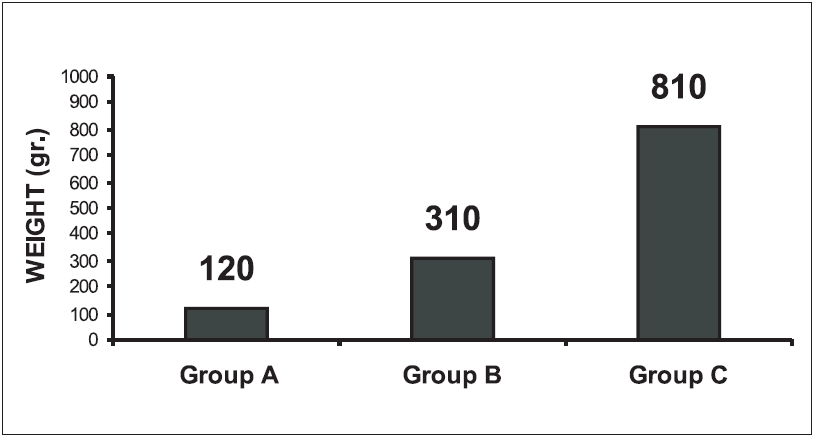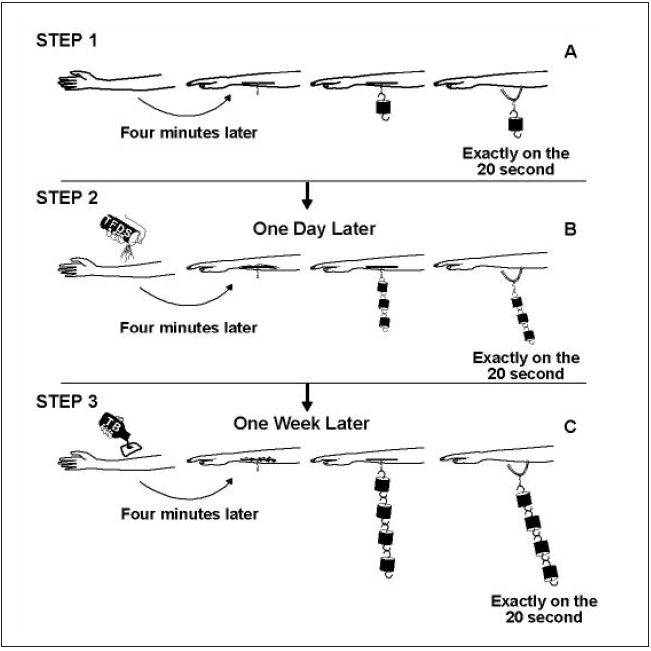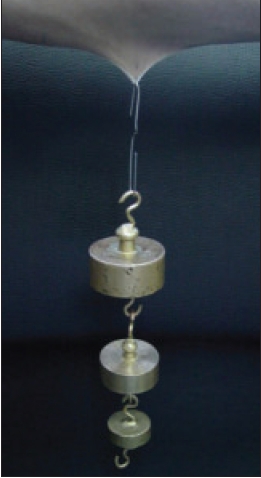Translate this page into:
Dressing spray enhances the adhesive strength of surgical dressing tapes
2 Department of Plastic Surgery, Fatih University Faculty of Medicine, Ankara, Turkey
Correspondence Address:
Evren Sarifakioglu
University of Fatih Faculty of Medicine, Department of Dermatology, Alparslan T�rkes Caddesi No: 57, 06510, Ankara
Turkey
| How to cite this article: Sarifakioglu E, Sarifakioglu N. Dressing spray enhances the adhesive strength of surgical dressing tapes. Indian J Dermatol Venereol Leprol 2006;72:353-356 |
Abstract
Background: The use of surgical adhesive tapes after minor surgical and dermatologic operations is widespread. Their use reduces the wound tension and separation and they ultimately improve the postoperative scar. The most commonly used wound adhesives to enhance the adhesiveness of the surgical tapes, are tincture of benzoin and mastisol.Aim: The purpose of the present study is to demonstrate the role of adhesive power of dressing spray with the adhesive tape application on the skin, which is widely used in clinics after the skin closure. Methods: Fifteen volunteers who were chosen among the medical personnel of the hospital comprised the study group. The skin of the flexor aspect of the 1/3 middle forearm of the subjects was used as the procedure region. The data is collected in the first, second and eighth days of the study. At the first stage of the study, an adhesive wound closure tape was applied to the skin without any compound of adhesives (group A). In the second and third stages, a thin coat of transparent film dressing spray (group B) and an adhesive compound of tincture of benzoin (group C) were applied to the skin before the adhesive tape placement, respectively. Different values of weights ranging between 50-900 gm were hanged by hooking into the center of the adhesive tape. The weights that caused complete separations of the tape from the skin after exactly 20 seconds were recorded in all groups. The data was analyzed by using Friedman test in order to calculate statistical significance between groups A, B and C. Results: The difference in adhesive power between control and groups B and C was found to be highly significant ( p < 0.05). Compound tincture of benzoin was observed to have greatest adhesive strength. Transparent film dressing spray was not as efficient as tincture of benzoin, but when compared with the control group, it enhanced the tape adhesion by 2-fold. Conclusion: The results indicated that dressing spray tested has an additional adhesive power besides its well known features and that it can be used as an efficient alternative material among other adhesive compounds.
 |
| The median values of weights that are required for complete separation of the SS�s from the skin after 20 seconds. Group A: control, group B: TFDS and group C: TB |
 |
| The median values of weights that are required for complete separation of the SS�s from the skin after 20 seconds. Group A: control, group B: TFDS and group C: TB |
 |
| Flow chart represents the study procedure. Step 1: adhesive tapes are applied to the skin without any compound of adhesives. Then a paper clip fashioned as a hook is placed in the center of adhesive tapes after 4 minutes. At the end of procedure, precisely on the time of 20 second, the complete separations of the tape from the skin with the drop of the different values of weights are recorded. In Step 2 and 3 the same procedure was repeated, using TFDS and TB, respectively. (TFDS: Transparent film dressing sprays, TB: Tincture of benzoin). |
 |
| Flow chart represents the study procedure. Step 1: adhesive tapes are applied to the skin without any compound of adhesives. Then a paper clip fashioned as a hook is placed in the center of adhesive tapes after 4 minutes. At the end of procedure, precisely on the time of 20 second, the complete separations of the tape from the skin with the drop of the different values of weights are recorded. In Step 2 and 3 the same procedure was repeated, using TFDS and TB, respectively. (TFDS: Transparent film dressing sprays, TB: Tincture of benzoin). |
 |
| Hanging weights with hooks |
 |
| Hanging weights with hooks |
 |
| A paper clip fashioned as a hook is placed in the center of adhesive tapes |
 |
| A paper clip fashioned as a hook is placed in the center of adhesive tapes |
Introduction
Conventional skin suturing techniques imply fast wound healing. However, they do have several disadvantages. These suturing techniques may necessitate the application of local anesthesia. During the healing procedure, "rail-road track" and "needle puncture" scarring are often seen along the incision line.[1] In addition, the use of foreign suture material may cause granuloma or infection. Gillman[2] first evaluated ′suturless skin closure′, where healing of incisions that are closed with sutures is compared with that of the plastic adhesive tape closure. The sutureless skin closure technique by using adhesive tape have the following advantages in the surgical practice:
- Prevents the local skin tension and necrosis at stitch;
- Decreases the rates of infection and overall morbidity;
- Decreases the overall costs and reduces the time spent in the operation room and;
- Maintains faster restoration of tensile strength on the skin edges.
On the basis of these unique performance and handling features, using adhesive tape technique is recommended for skin closure in many clinics. In the emergency and skin surgery departments, adhesive tapes have been introduced recently.[3] However; most authors suggested that there is unacceptable variability and poor reliability in their adhesive properties and that they could loose their adhesiveness with time, thereby leading to the separation of the incision edges.[3],[4],[5]
Transparent film dressing sprays (TFDS) have a widespread use in clinics for a variety of minor dry wounds. It seems that there is no consensus on the selection of the most effective adhesive material. With this study, we tried to evaluate if TFDS has an additional adhesive effect that may allow its use to the skin before the adhesive tape placements.
Methods
Fifteen healthy male volunteers from the medical staff who are employed in the Central Hospital of Fatih University Faculty of Medicine at Ankara, were selected for this study. Ethical clearance from the university ethical committee was obtained and informed consent was secured from all the volunteers who participated in the study. The skin of the flexor surface of the one third of middle right forearm was used as the procedure region. The evaluations were taken in 3 stages during the first, second and eighth days of the study. Throughout the study, 4-minute intervals were given between the application of the additives and the placement of adhesive tapes. Preliminary testing showed that it took at least 4 minutes for the test area to become completely dry after application of an additive. With this procedure, the adhesive tapes could be attached to skin much efficiently.
At the first stage of study, the wound closure tape (Steri-Stripβ, 1/4 ´ 4 in. 6 mm ´ 100 mm, 3M Health Care, St. Paul MN, USA), (S-S) was applied to the skin of forearms without any compound of adhesives before the S-S placement, as a control group (group A). During the second and third stages, a thin coat of TFDS (group B) and a compound of tincture of benzoin (TB) (group C) were applied to the entire skin before the S-S placement, respectively. Then a paper clip fashioned as a hook was placed in the center of adhesive tapes [Figure - 1]. The hanging weights with hooks were mounted into the loop of the paper clip, while the forearm was held at a horizontal position [Figure - 2]. Different values of weights ranging between 50-900 gms were then hooked into the center of the adhesive tape. The different values of weights that caused complete separations of the tape from the skin in precisely 20 seconds were recorded in all groups. The study procedure is shown in [Figure - 3].
Statistical analysis The data were analyzed using Friedman test to calculate statistical significance between groups A, B and C. Throughout the analysis, p -values less than 0.05 were considered as statistically significant.
Results
Transparent film dressing spray and TB did not cause any side effects in the overall subjects. The thin transparent film cover of dressing spray on the skin disappeared in 2 days, while the brown pigmentation of TB faded from the skin in a period of 6 days.
The quantities of the weights that led to the complete separation, (signed and sealed) from the skin was found to be 120 gm. in the control group and 310 gm. and 810 gm. in the study groups, who used TFDS and TB respectively [Figure - 4]. It was observed that the application of TB to the skin significantly increased the adhesiveness of S-S. Another interesting observation was that, weights of 700 gm. were carried by the S-S for an extra period of 10 minutes when TB was applied. When TFDS and TB were compared with the control group, the differences were found to be statistically significant ( p < 0.05). The comparison of the data between TFDS and TB groups were also found to be statistically significant ( p < 0.05).
Discussion
The laxity problem of the adhesive tapes is frequently encountered. The use of adhesives ultimately with surgical adhesive tapes, improves the postoperative scars. Surgical adhesive tapes usually contain an adhesive backing consisting of iso-octo-acrylate and n-vinyl-pyrolidone.[1] Additional adhesive compounds are commonly used to enhance the adherence of tapes. Mastisol and TB are some of the listed compounds that are most frequently used in clinics in order to reinforce the adhesive power of the tapes. It has been shown that, mastisol has a higher adhesive effect to the skin when compared with TB.[6] However; superior adhesive quality of TB has been also previously documented.[1],[6],[7],[8] Mastisol is not available in Turkey. Therefore, in the study, TFDS was compared with TB.
Some authors reported that skin irritation and contact dermatitis are common complications of mastisol and TB.[3],[9] In a brief report, Lesesne[9] reported the incidence of contact dermatitis with TB application on the skin. He also outlined the factors that are important during the application of additives. Contact dermatitis results from irritating chemicals being trapped between the skin and the adhesive. A superior adhesive material with less side effects and having an enhanced adhesive power is still lacking.
Transparent film dressing spray is easy and convenient to apply to the sutured area after surgical intervention, for numerous reasons. The film helps to provide protection for dry minor surgical and surface wounds. It contains an acrylic copolymer, ethyl acetate, acetone, isopropyl alcohol and propellants (butane 40 and dimethyl ether). As for the enhanced adhesive power of TFDS, we think that the acetone, ethyl acetate and dimethyl ether lead to a degreasing effect on the skin. The advantages of TFDS are that, it is in the form of a S-S and hence it does not have any skin coloration effect. The application of TFDS before S-S increases the adhesiveness of the steril strip, protects the wound and covers the wound area by a transparent film layer. The main disadvantages of TFDS are that it is not widely available in clinics, is more expensive and is not as strong as TB.
The study clearly demonstrated that TB provided a markedly greater adhesive strength than TFDS. However, TFDS also showed a 2-fold adhesive power effect, when compared with the control group. Transparent film dressing spray is a nonirritating material and also a protective compound. The agent could be used successfully in patients to enhance of the adhesiveness of surgical adhesive tapes, before the S-S placement into the injured area.
In this study, it is demonstrated that coating the entire application area with TFDS before the placement of S-S on the skin, provided a significant increase in adhesiveness, with lower incidence of discoloration or skin irritation. Transparent film dressing sprays may be used for different purposes (adhesiveness and/or wound protection) during the post-operative period.
To conclude, adhesive power of TFDS is not as strong as that of TB. When compared with the control group, TB increases the adhesiveness of S-S′s by approximately 7-fold, whereas the TFDS increased by 2-fold respectively.
Acknowledgments
We thank all the volunteers in the Fatih University Central Hospital in Ankara who very kindly gave their time during this study and Mr. Salih Ergocen of the Statistcs Department of the Ankara University Faculty of Medicine for his valuable contribution and assistance for the flow chart illustration and the statistical analyses of this study.
| 1. |
Katz KH, Desciak EB, Maloney ME. The optimal application of surgical adhesive tape strips. Dermatol Surg 1999;25:686-8.
[Google Scholar]
|
| 2. |
Gillman T. Healing of cutaneous abrasions and of incisions closed with sutures or plastic adhesive tape. Med Pract 1956;4:751-65.
[Google Scholar]
|
| 3. |
Kolt JD. Use of adhesive surgical tape with the absorbable continuous subcuticular suture. ANZ J Surg 2003;73:626-9.
[Google Scholar]
|
| 4. |
Rubio PA. Use of adhesive tap efor primary closure of surgical skin wounds. Int Surg 1990;75:189-90.
[Google Scholar]
|
| 5. |
Stillman RM, Bella FJ, Seligman SJ. Skin wound closure. The effect of various wound closure methods on susceptibility to infection. Arch Surg 1980;115:674-5.
[Google Scholar]
|
| 6. |
Mikhail GR, Selak L, Salo S. Reinforcement of surgical adhesive strips. J Dermatol Surg Oncol 1986;12:904-5.
[Google Scholar]
|
| 7. |
Carrington PR. Tacky but refined: A "slick" technique for dressing that hold better. Dermatol Surg 2000;26:929-30.
[Google Scholar]
|
| 8. |
Sarifakioglu N, Gokrem S, Toksoy K, Aslan G, Orun H. An interesting and useful balsamic resin used to increase the adherence of adhesive tape to the skin: Siam benjoin (tentuire de benjoin). Plast Reconstr Surg 2004;113:795-6.
[Google Scholar]
|
| 9. |
Lesesne CB. The postoperative use of wound adhesives. Gum mastic versus benzoin, USP. J Dermatol Surg Oncol 1992;18:990.
[Google Scholar]
|
Fulltext Views
3,318
PDF downloads
2,391





